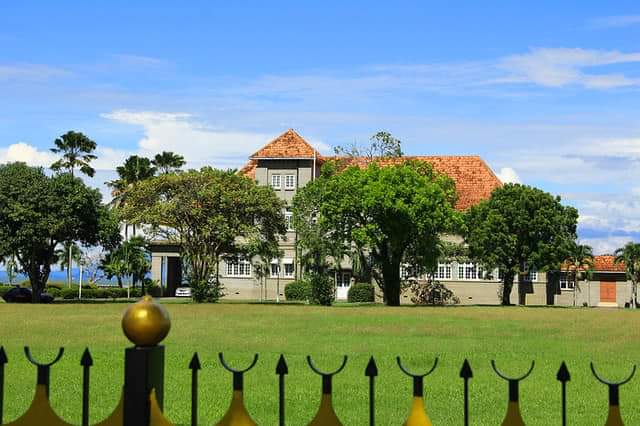𝗜𝘀𝘁𝗮𝗻𝗮 𝗞𝗲𝗱𝗮𝗵, 𝗥𝘂𝗺𝗮𝗵 𝗧𝘂𝗻𝗸𝘂 𝗞𝘂𝗱𝗶𝗻, 𝗧𝗮𝗸𝗵𝗱𝗶𝗿, 𝗮𝗻𝗱 𝗦𝗲𝗴𝗮𝗿𝗮 𝗡𝗶𝗻𝗱𝗮-𝘁𝗵𝗲 𝗺𝗲𝗺𝗼𝗿𝗶𝗲𝘀 𝗼𝗳 𝗘𝗻𝗶𝗴𝗺𝗮𝘁𝗶𝗰 𝗞𝗲𝗱𝗮𝗵'𝘀 𝗿𝗼𝘆𝗮𝗹𝘀 𝗮𝗻𝗱 𝗻𝗼𝗯𝗹𝗲𝘀 𝗶𝗻 𝗣𝗲𝗻𝗮𝗻𝗴.
𝘐𝘴𝘵𝘢𝘯𝘢 𝘒𝘦𝘥𝘢𝘩 𝘪𝘴 𝘯𝘰𝘵 𝘵𝘩𝘦 𝘰𝘯𝘭𝘺 𝘳𝘰𝘺𝘢𝘭 𝘱𝘳𝘦𝘴𝘦𝘯𝘤𝘦 𝘪𝘯 𝘗𝘦𝘯𝘢𝘯𝘨. 𝘛𝘩𝘦𝘳𝘦 𝘸𝘦𝘳𝘦 𝘰𝘵𝘩𝘦𝘳 𝘒𝘦𝘥𝘢𝘩 𝘳𝘰𝘺𝘢𝘭𝘴 𝘢𝘯𝘥 𝘥𝘪𝘨𝘯𝘪𝘵𝘢𝘳𝘪𝘦𝘴 𝘵𝘩𝘢𝘵 𝘮𝘢𝘥𝘦 𝘗𝘦𝘯𝘢𝘯𝘨 𝘵𝘩𝘦𝘪𝘳 𝘩𝘰𝘮𝘦 𝘧𝘰𝘳 𝘮𝘺𝘳𝘪𝘢𝘥𝘴 𝘰𝘧 𝘳𝘦𝘢𝘴𝘰𝘯𝘴.

𝗜𝘀𝘁𝗮𝗻𝗮 𝗞𝗲𝗱𝗮𝗵
Istana Kedah or Kedah House is the residence of the Sultan Kedah in Penang. It is located along Northam Road and designed in the European Gothic style by Charles Geoffrey Boutcher.[1]
The Istana is parged in Shanghai plaster, giving it a boulder-like appearance; a striking contrast to the effervescent white plasterwork of the ornate mansions along North Beach. [2]
It is the only mansion heavily influenced by the work of famous American architect Frank Lloyd Wright.
It is rumored that the Sultan built this house knowing that independence from Great Britain was imminent. Therefore, if Malaya gained independence, there is a slight chance that Penang might be returned to Kedah, its original rulers.
When the Sultan asked Tunku Abdul Rahman, Malaya's first prime minister, if Penang would be returned to Kedah, it is said that Tunku replied, "I think not. Penang is doing rather nicely as it is".
Istana Kedah is not open to the public.
https://goo.gl/maps/ANUiJYoeQ9vk8mxU8
📚: [1] Penang Travel Tips website.
📚: [2] The Penang House
📚: [3] Penang; An inside guide to its historic homes, buildings, monuments and parks.
📸: Penang Travel Tip

𝙏𝙖𝙠𝙝𝙙𝙞𝙧
𝐃𝐢𝐝 𝐲𝐨𝐮 𝐤𝐧𝐨𝐰 𝐭𝐡𝐚𝐭 𝐓𝐮𝐧𝐤𝐮 𝐀𝐛𝐝𝐮𝐥 𝐑𝐚𝐡𝐦𝐚𝐧 𝐬𝐩𝐞𝐧𝐭 𝐡𝐢𝐬 𝐫𝐞𝐦𝐚𝐢𝐧𝐢𝐧𝐠 𝐲𝐞𝐚𝐫𝐬 𝐢𝐧 𝐏𝐞𝐧𝐚𝐧𝐠, 𝐢𝐧 𝐚 𝐠𝐫𝐚𝐧𝐝 𝐛𝐮𝐧𝐠𝐚𝐥𝐨𝐰 𝐡𝐞 𝐥𝐨𝐯𝐢𝐧𝐠𝐥𝐲 𝐧𝐚𝐦𝐞𝐝 𝐓𝐚𝐤𝐡𝐝𝐢𝐫?
Located just a short walk away from Youth Park, Jalan Ayer Rajah was renamed to Jalan Tunku Abdul Rahman to honour our first Prime Minister, who chose to spend his remaining years in a bungalow here, which he named 𝐓𝐚𝐤𝐡𝐝𝐢𝐫 (Fate).
Below is an excerpt from Tunku Abdul Rahman's message, which prefaced an old book (Historical Personalities of Penang).
"When we moved to independence it was suggested that perhaps Penang and Province Wellesley might be handed back to Kedah, or at least Province Wellesley because it was under lease to the British Government, but I said, "No Penang has developed a character of its own and will make a useful member of the Federation of Malaya, so leave it alone". All the states went to make up Malaysia and Malaysia was the sole object of our loyalty.
I myself have decided to make my home in Penang, and it happened by accident rather than by design. When i left Kuala Lumpur on way to Kedah I stopped over for the Alliance Party, and my good friend Mr Tan Kim Yeow told me he had been offered two houses and would like me to take one of them.
Next day i went and saw the two houses nos 14 and 16 Jalan Ayer Rajah (now Jalan Tunku Abdul Rahman) and i took a liking to No.16. It was an old house built in 1929 with a semi-tropical architecture on 1.5 acres of land. I liked it and bought it and named the house "Takhdir" (fate).
📚 and 📸: Penang Hidden Gems

𝗥𝘂𝗺𝗮𝗵 𝗧𝗲𝗻𝗴𝗸𝘂 𝗞𝘂𝗱𝗶𝗻/𝗨𝗱𝗶𝗻𝗶 𝗛𝗼𝘂𝘀𝗲
Rumah Tengku Kudin was the official residence of Tengku Dhiauddin ibni almarhum Sultan Zainul Rashid, more widely known as Tengku Kudin, after he retired to a life in exile in Penang from 1884 to 1906.
The significance of the house derives primarily from its extraordinary architectural style. Udini House was constructed based on the concept and architectural layout drafted by Tengku Kudin, who combined British colonial influences with traditional Malay architectural style.
The Western motifs were a nod to Tengku Kudin's European education background and his fondness for European culture. As a result, he incorporated architectural elements from the Italian Renaissance period and European arches. At the same time, Tengku Kudin adopted traditional Malay local architecture for the interior of the house, which was much more suitable for the hot tropical weather.
He also designed a magnificent European garden for Udini House that includes a stable, an aviary, and a deer park. Intriguingly, there is also, an underground tunnel that leads directly from the house towards the open beach!
The house was later purchased by Tengku Baharuddin bin Tengku Meh, who was Raja of Setul when it was still a part of Kedah, as a holiday home.
📚: Udini House: The Decaying Mansion of a Kedah Prince in Exile (Penang Monthly, February 2021)
📸: Penang Travel Tips

𝗧𝗲𝗻𝗴𝗸𝘂 𝗗𝗵𝗶𝗮𝘂𝗱𝗱𝗶𝗻 𝗶𝗯𝗻𝗶 𝗮𝗹𝗺𝗮𝗿𝗵𝘂𝗺 𝗦𝘂𝗹𝘁𝗮𝗻 𝗭𝗮𝗶𝗻𝘂𝗹 𝗥𝗮𝘀𝗵𝗶𝗱 (𝗧𝗲𝗻𝗴𝗸𝘂 𝗞𝘂𝗱𝗶𝗻)
In 1821, Tengku Kudin was born in Penang into the royal family of Kedah. He is the second-eldest son of the 19th Sultan of Kedah, Muhammad Jiwa Azlin Muadzam Shah II. Tengku Kudin was given the title Raja Muda – or Crown Prince – shortly after he was born, making him the immediate heir to the throne.
His father arranged for him to receive European-style education to broaden Tengku Kudin's worldview to rule Kedah in the future. In 1867, Tengku Kudin married Tengku Arfah, the daughter of Sultan Abdul Samad of Selangor. Sultan Abdul Samad appoints Tengku Kudin as his special envoy or Wakil Yamtuan. As a Wakil Yamtuan, Tengku Kudin enjoyed special rights to govern the affairs of the Selangor Sultanate's territories: one of it was the Klang war that lasted till 1874.
Infuriated by Tunku Kudin's involvement in Klang War's battle for tin, Sultan Ahmad Tajuddin III of Kedah, his brother, stripped him of his royal title and permanently banned him from returning to Kedah. Tengku Kudin had in fact, as early as 1876 decided to leave for Kedah, but chose to move to Penang when he heard of his exile.
📚: Udini House: The Decaying Mansion of a Kedah Prince in Exile (Penang Monthly, February 2021)
📸: Wikipedia

𝗦𝗲𝗴𝗮𝗿𝗮 𝗡𝗶𝗻𝗱𝗮 𝗥𝗲𝘀𝗶𝗱𝗲𝗻𝗰𝗲 𝗯𝘆 𝗞𝘂 𝗗𝗶𝗻 𝗞𝘂 𝗠𝗲𝗵
Segara Ninda is a centuries-old mansion at the corner of Penang Road and Farquhar Street that once belonged to the Tengku Baharuddin bin Ku Meh, or Ku Din Ku Meh, the last Malay king that ruled Kingdom of Setul Mambang Segara, Southern Siam.
Setul was a Malay kingdom established by the cadet branch of the Kedah royal in the wake of a partition that took place in 1808. When the previous king of Setul, Tunku Abdul Rahman, had reportedly become insane, Setul was returned to Kedah in 1892 to be ruled by a high commissioner directly chosen by the Sultan Kedah. Ku Din Ku Meh was elected as the high commissioner because of his outstanding capabilities.
In 1901 Ku Din Ku Meh had acquired the plot of land upon which he built Segara Ninda. After his abdication in 1916, he involved himself in trading bird's nests, timber, rubber, and coconut. Penang was an ideal location for a permanent trading office, and so Segara Ninda became his office and holiday home.
Ku Din Ku Meh also bought Udini House as a holiday home.
📚: The Holiday Home of the Last King of Setul (Penang Monthly, June 2019)
📸: Penang Hidden Gems

𝗞𝘂 𝗗𝗶𝗻 𝗞𝘂 𝗠𝗲𝗵
While Ku Din Ku Meh was not a direct descendant of the Setul royal house, he was born of nobility. In 1892, he was first elected as High Commissioner of Setul after the kingdom was left vacant. In 1900, Ku Din was appointed by the Siamese Government as the Governor of Setul.
As a statesman, his career reached its peak when he was proclaimed as King of Setul. The proclamation was affirmed by King Chulalongkorn of Siam and by the governors of the southern provinces of Siam, as an attempt to incorporate Setul under Siamese sovereignty.
In 1909 when the Anglo-Siamese Treaty was signed, Setul was recognised as sovereign territory of Siam.
Ku Din Ku Meh abdicated his throne in 1916 because of poor health. That same year, Kingdom of Siam dissolved the Malay kingship system in Setul, and the territory was renamed Satun.
Ku Din Ku Meh passed away in Setul in 1932.
📚: The Holiday Home of the Last King of Setul (Penang Mothly, June 2019)
📸: Wikipedia
____
Author of this article:
Emilia Ismail is the co-founder of Penang Hidden Gems and is an amateur “historian” who enjoys discovering lesser-known historical information about Penang.

